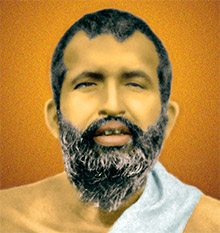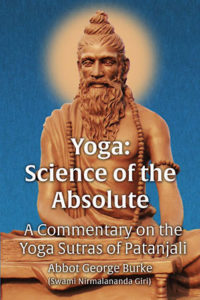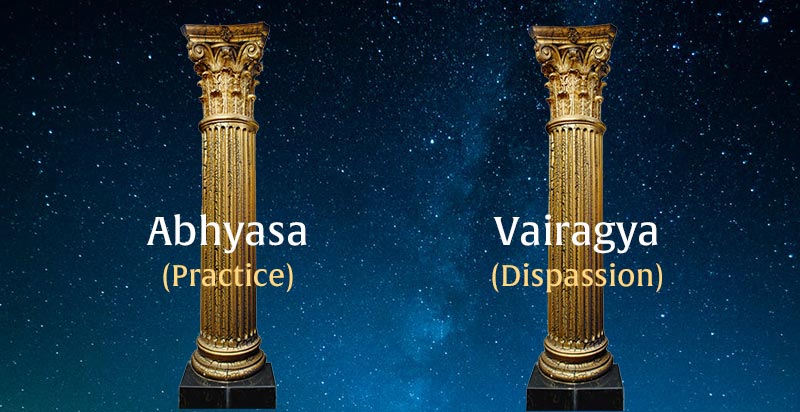Sutra 1:12. Their suppression [is brought about] by persistent practice [abhyasa] and non-attachment [vairagya].
Two things are needed for the ending of mental modifications. One is abhyasa–sustained spiritual practice. This is why Krishna speaks of abhyasa yoga. The other is purely psychological: vairagya. A Brief Sanskrit Glossary defines vairagya as: “Non-attachment; detachment; dispassion; absence of desire; disinterest; or indifference. Indifference towards and disgust for all worldly things and enjoyments.”
Sutra 1:13. Abhyasa is the effort for being firmly established in that state [of chitta-vritti-nirodha].
Jnaneshwara expands on this, saying: “Abhyasa means choosing, applying the effort, and doing those actions that bring a stable and tranquil state.” Shankara simply says that abhyasa consists of the observance of yama and niyama, which are to be discussed later on.
Sutra 1:14. It [abhyasa] becomes firmly grounded on being continued for a long time, without interruption and with reverent devotion.
Vyasa: “Carried through with austerity, with brahmacharya, with knowledge and with faith, in reverence it becomes firmly grounded.”
Shankara: “Unless it is for a long time, and unless it is uninterrupted, the practice does not become firmly grounded.”
Sutra 1:15. The consciousness of perfect mastery [of desires] in the case of one who has ceased to crave for objects, seen or unseen, is Vairagya.
 Sri Ramakrishna said: “A certain woman said to her husband: ‘So-and-so has developed a spirit of great dispassion for the world, but I don’t see anything of the sort in you. He has sixteen wives. He is giving them up one by one.’ The husband, with a towel on his shoulder, was going to the lake for his bath. He said to his wife: ‘You are crazy! He won’t be able to give up the world. Is it ever possible to renounce bit by bit? I can renounce. Look! Here I go.’ He didn’t stop even to settle his household affairs. He left home just as he was, the towel on his shoulder, and went away. That is intense renunciation.
Sri Ramakrishna said: “A certain woman said to her husband: ‘So-and-so has developed a spirit of great dispassion for the world, but I don’t see anything of the sort in you. He has sixteen wives. He is giving them up one by one.’ The husband, with a towel on his shoulder, was going to the lake for his bath. He said to his wife: ‘You are crazy! He won’t be able to give up the world. Is it ever possible to renounce bit by bit? I can renounce. Look! Here I go.’ He didn’t stop even to settle his household affairs. He left home just as he was, the towel on his shoulder, and went away. That is intense renunciation.
“There is another kind of renunciation, called ‘markata vairagya,’ ‘monkey renunciation.’ A man, harrowed by distress at home, puts on an ochre robe and goes away to Benares. For many days he does not send home any news of himself. Then he writes to his people: ‘Don’t be worried about me. I have got a job here.”
Vairagya is not an on-and-off matter, but a permanent cessation of any desire for any object whatsoever. Vyasa says that one with true vairagya “is inwardly aware of the defects in objects by the power of his meditation.”
Sutra 1:16. That is the highest Vairagya in which, on account of the awareness of the Purusha, there is cessation of the least desire for the Gunas.
The preceding verse was about vairagya in relation to objects. This goes further and speaks of dispassion-desirelessness is relation to the three modes of Prakriti, the gunas. These are discussed at length in the Bhagavad Gita, but simply put they are the three modes of energy behavior–qualities of energy. A Brief Sanskrit Glossary defines guna as: “Quality, attribute, or characteristic arising from nature (Prakriti) itself; a mode of energy behavior. As a rule, when “guna” is used it is in reference to the three qualities of Prakriti, the three modes of energy behavior that are the basic qualities of nature, and which determine the inherent characteristics of all created things. They are: 1) sattwa–purity, light, harmony; 2) rajas–activity, passion; and 3) tamas–dullness, inertia, and ignorance.”
There can be attachment to the qualities of subtlety, intelligence, and purity (sattwa), of effectiveness and efficiency and mastery (rajas), and stability and steadiness (tamas). But these, too, are illusory like other objects.
 However such vairagya does not come from insight into the nature of objects or gunas but from knowing the Self. Only when we enter fully into the Self will all desire of any kind cease. For that reason Self-knowledge or atma-jnana should be our aim at all times, for that alone will eliminate all that stands between us and perfect freedom (moksha or jivanmukti).
However such vairagya does not come from insight into the nature of objects or gunas but from knowing the Self. Only when we enter fully into the Self will all desire of any kind cease. For that reason Self-knowledge or atma-jnana should be our aim at all times, for that alone will eliminate all that stands between us and perfect freedom (moksha or jivanmukti).








